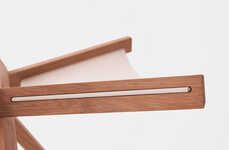Look closely at the Chair 3/4 and you'll notice that something about it is off. Perhaps difficult to discern from certain angles, the asymmetry and even disconnect within the structure seems to break the rules of furniture design.
This was precisely the intention of Sandro Lominashvili, who wished to challenge the parameters of creating a simple seating object. Tubular steel was chosen as the ideal material, for its strength exceeds the weight demands that this item should ever have.
There are three load-bearing legs on the Chair 3/4, as you'll remark the separation between the seat and the rear left prop. To ensure that the chair is adequately sturdy and balanced for the sitter, one leg in front was welded at an angle.
Support-Separated Seating
The Chair 3/4 is Unsettling to See, But Really Rather Stable
Trend Themes
1. Asymmetric Seating - Designing furniture with intentional asymmetry challenges traditional design and creates unique aesthetic experiences.
2. Tubular Steel Furniture - Using tubular steel as a material for furniture design provides unique material properties and design possibilities.
3. Load-bearing Leg Design - Incorporating load-bearing legs into furniture design can create distinctive and visually interesting products.
Industry Implications
1. Furniture Design - Furniture designers can utilize intentional asymmetry and load-bearing leg design principles to create unique products and experiences.
2. Materials Manufacturing - Manufacturers can promote the use of tubular steel as a versatile and strong material for furniture design.
3. Retail and Interior Design - Retailers and interior designers can showcase and promote the aesthetic and functional benefits of asymmetric seating and load-bearing leg design principles.






